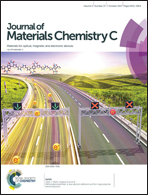Bright structural coloration from organic polymeric photonic crystals with robust heat-resistance†
Abstract
Organic polymeric microspheres, which can be easily synthesized through simple emulsion polymerization, are important building blocks of photonic crystal structural color materials. However, the poor heat resistance of organic polymeric photonic crystals is the intrinsic drawback that severely limits their practical application. In this study, novel polymeric photonic crystal structures with robust heat resistance are developed from the self-assembly of thiodiphenol–formaldehyde (TPF) microspheres. TPF microspheres with controllable particle size and high monodispersity are synthesized through polycondensation and cross-linking reaction between 4,4′-thiodiphenol and formaldehyde via a hydrothermal process. Derived from the highly cross-linked network structure and high content of aromatic rings and sulfur atoms of the TPF microspheres, the obtained polymeric photonic crystals exhibit bright structural colors and excellent heat resistance up to 250 °C. By contrast, general polystyrene photonic crystals possess poor heat resistance (<110 °C), due to the linear macromolecular structure. The distinct heat resistance feature of TPF structural colors is highly important for expanding their practical applications.



 Please wait while we load your content...
Please wait while we load your content...